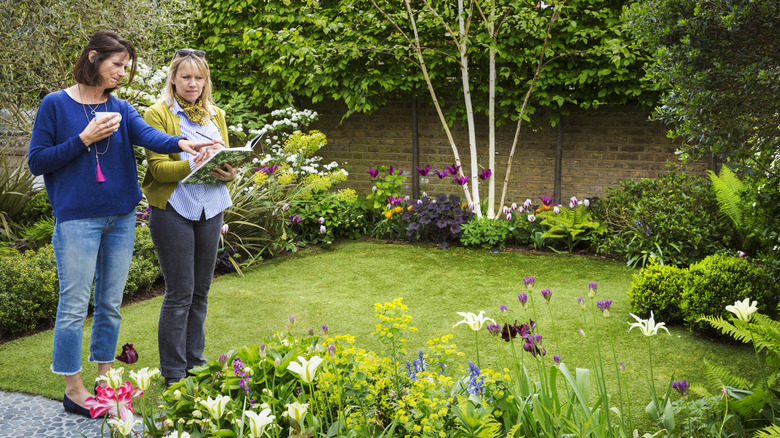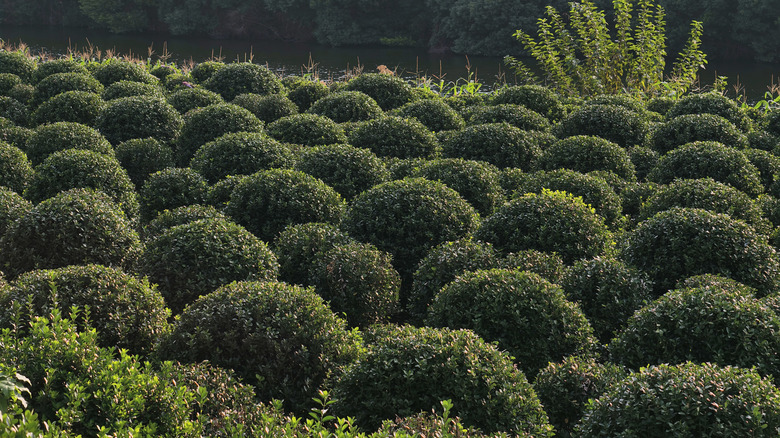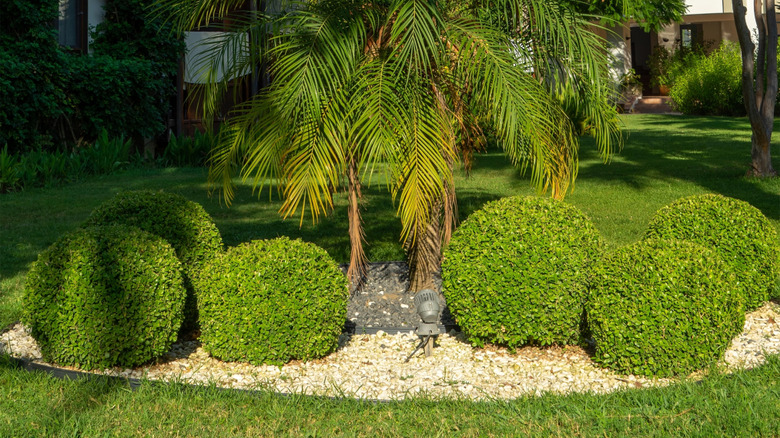Why Blobbery Bushes Are Replacing Topiary In Laid-Back Garden Design
We may receive a commission on purchases made from links.
You've been wracking your brain, scouring gardening Pinterest albums, and checking a mountain of garden design books out from the library in the hopes of finding genius ideas to spice up your boring garden. While turning to trends isn't always the answer — and, in fact, can leave you with landscaping that dates all too quickly — we strongly believe this surprisingly easy-to-achieve topiary style is the inspiration you've been seeking. As the name suggests, blobbery bushes are clipped rather lazily, at least where topiary art is concerned, into flattened balls or blobs of varying heights and widths. A blobbery refers to the close-knit grouping of said blobs in a garden.
Blobbery bushes are a form of topiary, but what exactly is topiary, and how is it used in a yard? Evidence for the use of topiary in Europe dates back to Ancient Rome, where writing by Pliny the Elder describes shrubs shaped into animals, figures, inscriptions, and obelisks. Later, the Renaissance saw a surge in topiary's popularity in Italy and later in France and England. Sculptured plants, often small trees, also feature heavily in traditional Chinese garden design and the Zen gardens of Japan. Most, if not all, of the shapes common in contemporary topiary are the result of centuries of development, including cone, lollipop, poodle, spiral, pompom, pyramid, column, and creative forms like squirrels and immense cloud-like hedges that would rival the creations of Edward Scissorhands. In fact, blobs and blobberies grew out of a specific traditional topiary form: the box ball.
Trending blobbery bushes: The origin and concept explained
A blobbery shrub or blob is a singular plant cut into a slightly flattened ball. A blobbery is a congregation of blobs of various sizes and shrub species. The resulting look is undeniably topiary but with a whimsical and desultory slant. You might occasionally see blobs referred to as mushrooms, donuts, boules, pillows, and clouds. Allow an individual blob to grow big, and you can remove the lower branches and prune it into a multi-stemmed blob that resembles a shaggy cluster of bubbles on a slender trunk.
The origins of blobbery are muddy. The contemporary trend appears to have originated in the U.K., first championed and likely coined by West Sussex-based nursery and garden design company Architectural Plants in the 1990s. However, Japanese and Chinese gardening traditions have also long used blobbery-like planting arrangements — in particular, with moss.
These rotund sculptural shrubs reportedly appeared in numerous gardens by leading designers at the RHS Chelsea Flower Show 2025. Balmoral Cottage, part of the U.K.'s National Garden Scheme, boasts gardens packed full of undulating blobbery bushes and singular blobs set growing next to whimsical topiary birds, squirrels, and layered cake-like trees. Arguably, the most iconic example worldwide is The Blobbery, formerly known as The Teardrop Garden, located in the historic Retford Park estate in Bowral, New South Wales. The design was created by Head Gardener Rick Shepherd in the late 2010s, and it features bush germander (Teucrium fruticans), licorice plant (Helichrysum petiolare), and mountain plum pine (Podocarpus lawrencii), which have been pruned into large blobs bordering a gravel pathway leading to the former home.
Blobbery bushes boast benefits over traditional topiary forms
Blobs are quick to clip, especially when compared with something complicated like Japanese cloud pruning. In the plant's first year, bundle the branches together and snip them off straight. Shape the shrub in its second year. Likewise, while traditional topiary designs follow the rule of three, the constant clipping means blobberies eventually become a singular form, making plant numbers less important. Shrubs molded into complicated classic topiary shapes with shears and wire thrive in containers. Conversely, blobbery shrubs are best suited to life in an in-ground garden bed.
There's a lot of room for experimentation with blobbery bushes. Pretty much any plant you want to use will work, so long as it doesn't mind being clipped. Traditional topiary pruners favor evergreen shrubs, but with blobs, you can trim deciduous shrubs, too. In fact, mixing and matching the two provides exciting seasonal interest in a garden and helps mitigate disease and pest risk. Buxus, or boxwood, varieties have long been the go-to evergreen topiary shrub; Ten Florida Foliage Buxus sempervirens 'Green Mountain' saplings are available on Amazon for $55.
Some of the best companion plants for your boxwood blobs include yew (Taxus), hardy pittosporum, and box honeysuckle (Lonicera nitida) cultivars, along with yellow blooming Jerusalem sage (Phlomis fruticosa) and fragrant flowering Viburnum tinus. Pines and conifers provide a variety of foliage colors: consider the brilliant green Japanese cedar (Cryptomeria japonica), the yellow-in-winter dwarf mountain pine (Pinus mugo 'Mops'), or the cerulean-hued dwarf mountain plum-pine cultivar (Podocarpus lawrencii 'Blue Gem'). The only real rule when creating a good-looking blobbery is to plant shrubs in dense groups and build your collection over time.


